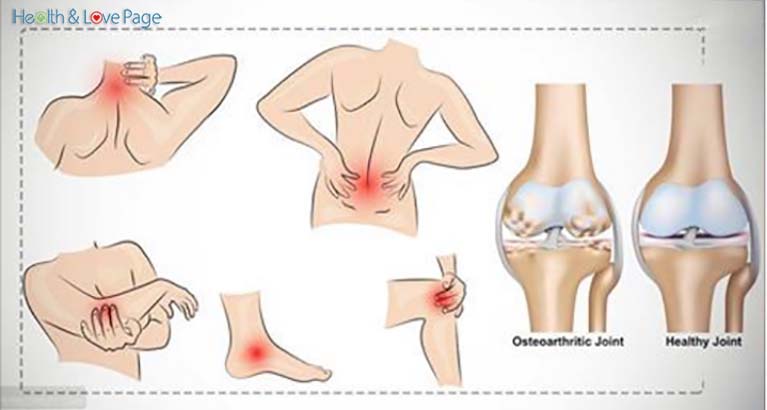If you experience permanent or temporal joint pain you are aware how it can influence your life. Joints are important body parts that connect, support your bones and enable you to move.
If they are damaged in some way due to injury or disease it can significantly affect your quality of movement.
A national survey points out that almost third of all adults have some joint pains. One of the most common is the knee pain then the hip and shoulder pain but also other joints can be affected by this pain. The older we get, the greater the risk of developing joint pain.
Reasons for Joint Pain
There are two most important reasons that cause joint pains such as: an injury that affects the ligaments and the tendons that surround or are within the joints.
An acute joint pain can be mild and go away within several weeks while the chronic one can be long-term which can last permanently.
Osteoarthritis and Rheumatoid arthritis are the most common types of chronic joint diseases.
Osteoarthritis is the most common chronic condition that is a result of wear-and-tear of the joints, injury or excess weight.
By time, the bone cartilage can wear down and thus cause bone grate on bone. In this way, the joint space gets damaged.
Rheumatoid arthritis is an inflammatory process where the immune system attacks its own joints and inflames the tissue that protect the joints. Such an inflammation can lead to damage of the surrounding bones.
Joint pain can also be caused by bursitis or inflammation of the bursa, the cushion around the joint, gout or collection of toxins in the joint space, strains of joint’s ligaments and bone cancer.
Symptoms and Signs of Joint Pain
The following list includes symptoms that are connected with joint issues:
- Swelling of the joint
- Redness of the joint
- Joint warmth
- Joint tenderness
- Locking of the joint
- Limping
- Stiffness in the joints
- Loss of range of motion
- Weakness of the joints
Treatment of Joint Pain
Treating joint pain can help you relieve the inflammation and pain and preserve the proper function of the joints.
The following joint treatment suggestions may help you reduce the pain and improve your quality of life:
1. Repetitive stress of the joins can harm the joint function. So, try to avoid such stress or in acute conditions you might need to stop using the joint so that it heals properly.
2. Apply some packs of ice or some frozen peas to your joints for about 15-20 minutes, several times a day.
3. Fill a tub with a warm water and two cups of Epsom salt and a pinch of baking soda and soak your joints for about 15 minutes. If you can’t soak them, fill some bowl with water, half a cup of Epsom salt and a pinch of baking soda.
4. Relax your muscles and improve the circulation of blood with a warm shower.
5. A healthy weight will not put an excessive pressure on your joints. Therefore, for each 5 extra pounds your joints carry additional 20 pounds. But, if you lose 5-10 lb, you can solve many health problems.
6. Do regular exercise because in that way you will strengthen the muscles that support and lubricate the joint. So, walking, biking and swimming are ideal activities that will help you control weight. But, if you have knee joint pain it is suggested to run on soft surface, for example grass.
7. You can reduce joint pain with an anti-inflammatory diet. This includes turmeric-ginger tea. Combine two cups of hot water, half a teaspoon of ground ginger, half a spoon of ground turmeric and lemon and drink this tea four times a day. Avoid using sugar, processed food, artificial sweeteners, packaged ready-made meals, white rice, red meat and bread. Restrict your consumption of soy, wheat and corn. Include more green veggies, seeds, legumes, whole grains such as millet, brown rice, barley, buckwheat and amaranth.
8. If you have difficulty getting out of chair, you may need a physical therapist who is specialized in joint problems. He will teach you the suitable techniques how to remove the pain and strengthen the body.
9. Additional assistive devices including canes, shoe inserts, braces and splints can distribute your weight equally and remove the load from your joints. However, before you take some assistive device, consult your doctor.
10. Magnesium intake can relax the muscles and nerves so there won’t be stiffness nor pain. Consume 300-600 mg of magnesium powder before you go to bed. Every morning, drink some freshly squeezed juice from leafy green vegetables. Replace the intake of red meat and chicken with some small beans such as split peas, lentils and moong dal. They are powerful sources of magnesium.
What If the Joint Pain Is Persistent?
If you can’t remove the joint pain and it still becomes swollen, uncomfortable, tender and red, it is high time you see a doctor. If you have some injury that is followed by an intense swelling, pain, joint deformation and inability to use, you definitely have to see a doctor.
Via Cure Joy

